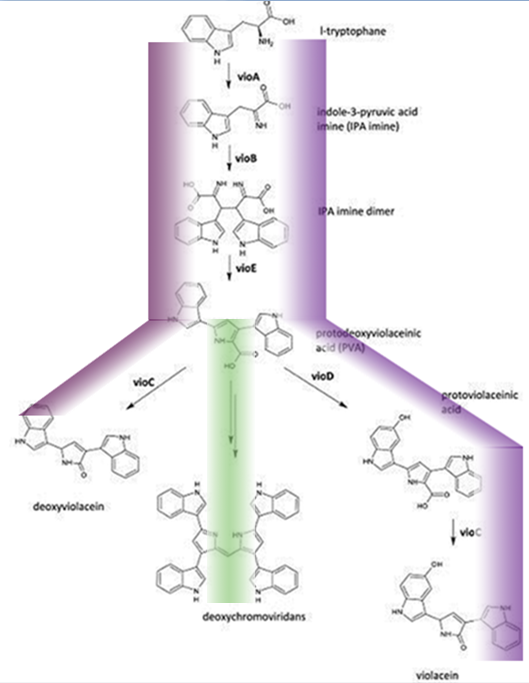Team:SJTU-BioX-Shanghai/Project/project2.1
From 2012.igem.org
(Difference between revisions)
Zhiantinglan (Talk | contribs) (→Biosynthesis - Violacein) |
Zhiantinglan (Talk | contribs) (→Biosynthesis - Violacein) |
||
| Line 35: | Line 35: | ||
| - | + | ==Background== | |
Violacein is a pigment produced by several bacteria through pathway of 5 related genes, ''vioA'', ''vioB'', ''vioC'', ''vioD'' and ''vioE''. It was initially discovered in ''Chromobacterium violaceum''. This metabolite of tryptophan has such special applications as antibacterial, anti-trypanocidal, anti-ulcerogenic, and anticancer drugs. | Violacein is a pigment produced by several bacteria through pathway of 5 related genes, ''vioA'', ''vioB'', ''vioC'', ''vioD'' and ''vioE''. It was initially discovered in ''Chromobacterium violaceum''. This metabolite of tryptophan has such special applications as antibacterial, anti-trypanocidal, anti-ulcerogenic, and anticancer drugs. | ||
| Line 41: | Line 41: | ||
There are two interesting branches in this pathway which could be utilized in service of verification of the ''membrane rudder''. We can identify the different end-products by means of separation, such as thin-layer chromatography (TLC), or high-performance liquid chromatography (HPLC). The product proportion change demonstrates the efficiency of alteration in reaction direction. | There are two interesting branches in this pathway which could be utilized in service of verification of the ''membrane rudder''. We can identify the different end-products by means of separation, such as thin-layer chromatography (TLC), or high-performance liquid chromatography (HPLC). The product proportion change demonstrates the efficiency of alteration in reaction direction. | ||
| - | + | ==Violacein Biosynthetic Pathway== | |
[[Image:12SJTU_VioPathway.png|thumb|250px|right|''Fig.1'' :The violacein biosynthetic pathway. The purple line indicates the biosynthetic flux of pigment deoxyviolacein and violet. The green line indicates the the biosynthetic flux of pigment deoxychromoviridans.]] | [[Image:12SJTU_VioPathway.png|thumb|250px|right|''Fig.1'' :The violacein biosynthetic pathway. The purple line indicates the biosynthetic flux of pigment deoxyviolacein and violet. The green line indicates the the biosynthetic flux of pigment deoxychromoviridans.]] | ||
| Line 51: | Line 51: | ||
vioD hydroxylates 5-position indole ring, then the other 2-position indole ring is processed by VioC to create the oxindole, and in this way violacein(''3rd main product'') is produced. | vioD hydroxylates 5-position indole ring, then the other 2-position indole ring is processed by VioC to create the oxindole, and in this way violacein(''3rd main product'') is produced. | ||
| - | + | ==Design of Membrane Assembly== | |
Theoretically our membrane rudder offers a method to fine-tune reaction direction, and in the meantime decrease side-products quantity. | Theoretically our membrane rudder offers a method to fine-tune reaction direction, and in the meantime decrease side-products quantity. | ||
| Line 66: | Line 66: | ||
As long as VVD is photo-induced and dimerized, they could act like magnets that pull vioC and vioD together,making it easier for intermediates to undergo catalyzation of vioC and vioD. In this case violacein should be the dominant product we expect. | As long as VVD is photo-induced and dimerized, they could act like magnets that pull vioC and vioD together,making it easier for intermediates to undergo catalyzation of vioC and vioD. In this case violacein should be the dominant product we expect. | ||
| - | + | ==Results and Discussion== | |
Plasmids as designed has been successfully constructed and transformed into ''E. coli''. To ensure the efficiency of membrane switch, the bacteria culture was under bluelight during induction period. After 5h, there appeared to be visible pigments particles in the liquid. We further analyzed the extracts using more sensitive methods, e.g. High-performance liquid chromatography (HPLC) (for a detailed description of the protocols see the page "Protocal"). | Plasmids as designed has been successfully constructed and transformed into ''E. coli''. To ensure the efficiency of membrane switch, the bacteria culture was under bluelight during induction period. After 5h, there appeared to be visible pigments particles in the liquid. We further analyzed the extracts using more sensitive methods, e.g. High-performance liquid chromatography (HPLC) (for a detailed description of the protocols see the page "Protocal"). | ||
| Line 103: | Line 103: | ||
Although the theoretical production of violacein biosynthetic pathway composed of only three pigments, the separation result of HPLC depends on many different factors, including the purity of extraction, stationery phase type, the detector wavelength, etc. However, we did not have time to perform any optimizations with respect to extraction protocol, HPLC conditions etc., therefore the final result of HPLC could be much more legible with less interference of noise peak. Despite that the experiment was repeated more than three times with similar results. | Although the theoretical production of violacein biosynthetic pathway composed of only three pigments, the separation result of HPLC depends on many different factors, including the purity of extraction, stationery phase type, the detector wavelength, etc. However, we did not have time to perform any optimizations with respect to extraction protocol, HPLC conditions etc., therefore the final result of HPLC could be much more legible with less interference of noise peak. Despite that the experiment was repeated more than three times with similar results. | ||
| - | + | ==Reference== | |
1. Balibar, C. J. and C. T. Walsh (2006). "In vitro biosynthesis of violacein from L-tryptophan by the enzymes VioA-E from Chromobacterium violaceum." Biochemistry 45(51): 15444-57. | 1. Balibar, C. J. and C. T. Walsh (2006). "In vitro biosynthesis of violacein from L-tryptophan by the enzymes VioA-E from Chromobacterium violaceum." Biochemistry 45(51): 15444-57. | ||
Revision as of 18:52, 26 September 2012
 "
"



